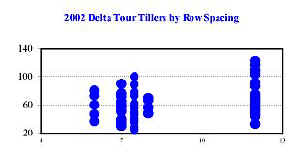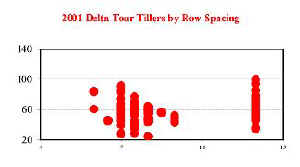|
2002
Wheat Quality Council – Delta Soft Winter Wheat Tour |
|||||||||||||||||||
|
|
|||||||||||||||||||
|
|
|||||||||||||||||||
|
Tour
participants gathered in Little Rock, Arkansas, divided into tiller
counting teams and traveled on various routes through the Delta. The
Tour does not look at the entire wheat crop in any soft wheat state
because acreage is widely dispersed. To make the most of limited time
and resources, only counties with the highest concentrations of wheat
acres are sampled. There is a high bias in the summary numbers. Merely counting tillers is not enough for accurate yield forecasting. Head size and kernel weights are two additional yield factors that Tour participants are unable to measure or estimate effectively. This is because the Tour is conducted while heads are still being formed. However, preliminary yield ranges can be obtained through simple tiller counting. A useful rule of thumb for winter wheat is to equate approximately one bushel per acre of yield potential for each tiller per square foot. The one-to-one ratio may be tweaked upward or downward according to growing conditions immediately following the heading phase. Severe drought stress or heavy disease pressures would dictate that a ratio of something less than 1:1 be used. Very favorable conditions and corresponding larger than normal head size might lead to a ratio of 1¼ bushels per tiller or more. In
that spirit, we gather as many tiller counts from as many counties as we
possibly can during each year’s Tour. We also record observations of
disease pressure, soil moisture condition, and other pertinent remarks.
More often than not, when Tour participants encounter growers while
they’re out on the crop scout trail we gain additional insights into
the prospects for each year’s crop. Arkansas and neighboring states’ wheat counties appear to have so-so yield prospects this season. However, the BIG story is the abandonment of flooded wheat acres. Perhaps as many as 25% of acres seeded last fall will not be harvested. Generally speaking,
|
surviving wheat fields may have
stronger yield potential to the north and east of I-70 while poorer
yields appear to be in prospect to the south of this highway. Though a
number of high-yielding fields were found, the majority were just
mediocre. The
average tiller count for the entire Tour this year isn’t much
different than last year’s statistic. We found an average of 61.5
tillers per square foot this year compared to 58.1 per square foot last
year in these selected counties. I would say that there is not a
significant difference in 2002 yield prospects overall because the
slightly elevated tiller count this year resulted from an unusually high
proportion of fields that were broadcast
last fall. Over-crowded stands resulted and that tends to stunt average
head size. During the 2001 Delta Wheat Tour the proportion of sampled
fields that had been broadcast was only 34%
whereas this year we found 53%
of sampled fields were broadcast, skewing the overall tiller count
slightly upward.
|
||||||||||||||||||
|
|||||||||||||||||||
| Back to Top | |||||||||||||||||||

